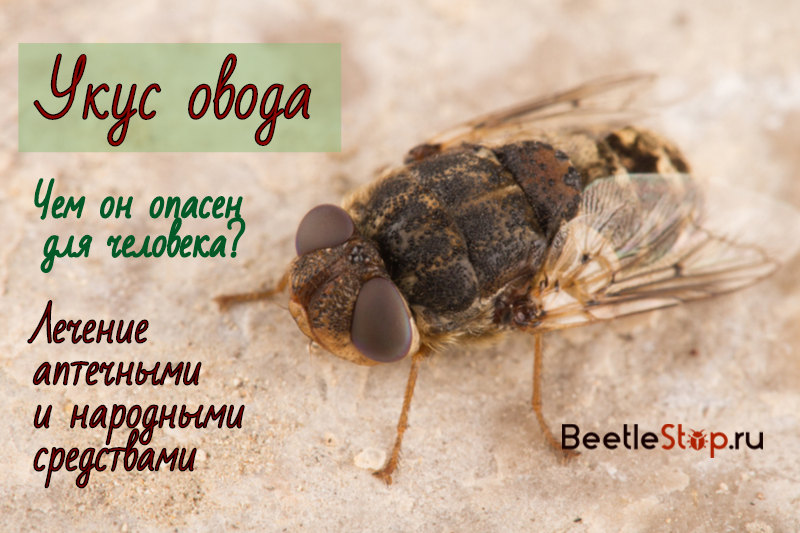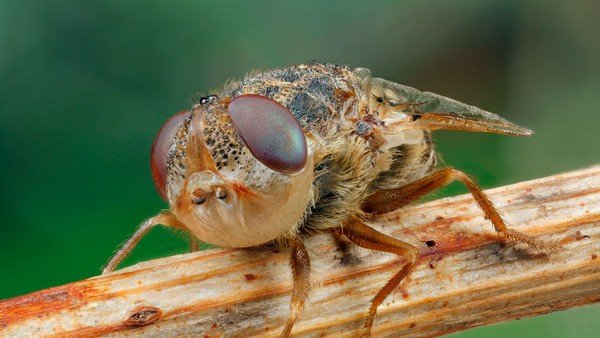Gadfly bite: symptoms, treatment, consequences

The gadfly is a parasitic fly of medium size, which scientists attribute to the family of dipterans. During an attack on humans or animals, the female damages their skin and lays eggs in the soft tissues. The bite of the gadfly does not go unnoticed, as it causes a sharp and severe pain. But the main danger is not in uncomfortable sensations, but in the possible consequences of damage to the skin. A person develops allergic reactions, develops symptoms of general intoxication, and after a while gadfly larvae start. Treatment of a tumor after a bite of a gadfly consists of taking antihistamines and anti-inflammatory drugs, and in complicated cases, antibiotics.
Bite Symptoms
It is often difficult for a person to understand which insect has bitten him - a bee, wasp or mosquito. But not in the event of a gadfly attack. This insect after a bite does not fly away, but continues to circle over an adult or a child, choosing a place for a new attack. Damage caused by a parasitic fly is also very characteristic.
“This is interesting: Many people believe that gadflies and horseflies are one and the same insect. It's not like that at all. Horseflies attack an animal or person and feed on their blood. An adult gadfly lives off the substances that its body has accumulated at the larval stage. "He is not able to replenish these reserves, so his lifespan is very short."
During the bite, the gadfly makes a puncture, leaving two small holes on the skin. Saliva enters the wounds, along with which toxic compounds penetrate into the systemic circulation. A person can find out that he was the victim of an attack of a gadfly by the following characteristic signs:
- severe pain during a bite;
- instant redness of the skin;
- intolerable skin itching provoked by toxins;
- the rapid formation of large edema.
If you do not provide first aid to the victim after a bite of the gadfly, the tumor can greatly increase in size. A harmful insect often along with saliva injects pathogenic bacteria under the skin of a person. After a few days, an abscess forms at the site of the bite, which gradually enlarges and causes severe pain when pressed.
What can happen right after a bite?
Toxic compounds, after penetration under the skin, enter the bloodstream and spread throughout all tissues and organs. Even a person with a very high resistance to allergic and infectious agents has symptoms of general intoxication:
- rise in temperature above subfebrile values (38.5 ° C);
- migraine-like headaches;
- dyspeptic disorders - nausea, bouts of vomiting, diarrhea due to a sharp rise in temperature.
Perhaps the development of a strong allergic reaction, including anaphylactic shock. The place of the bite of the gadfly itches, the appearance of an elevated papule is possible.

Signs of an allergic reaction
The greatest danger to human health arises with the development of a sensitization reaction.People who are prone to allergies are more likely to die in the absence of qualified medical care. For which symptoms of a bite of a gadfly in a person should quickly deliver the victim to the nearest hospital:
- the development of extensive edema, quickly spreading to healthy areas of the skin;
- the occurrence of severe itching against the background of redness of a significant area of the skin;
- sensation of acute pain, which only intensifies over time;
- severe dizziness, not allowing the victim to be in an upright position;
- bouts of vomiting, the intervals between which are only reduced;
- lethargy, apathy, indifference to everything happening around;
- decreased motor activity, fatigue, weakness.
The severity of an allergic reaction after a bite of a gadfly can be so strong that the bladder and (or) intestine are involuntarily emptied in the victim.
The consequences of an insect attack
From the general state of human health, his age, the presence of chronic pathologies depends on how much the bite of the gadfly passes through. It may take several days to fully recover, and in case of complications, treatment will be delayed for months. An insect attack rarely does without consequences, the most dangerous of which include the following:
- Edema of soft tissues. They can be so strong that the entire upper or lower limb swells. At the site of the bite, redness and rash appear, similar to the symptoms of urticaria. To eliminate this condition will help taking any antihistamine. The dangerous consequences of a bite of the gadfly occur when the scalp is damaged - the larynx and tongue begin to swell, hindering the free access of air, causing suffocation and asphyxiation;
- Parasitic infestations. While digging the skin, the gadfly introduces eggs into the soft tissues of a person for further development. They are protected by a strong shell, so the immune system does not respond to the penetration of foreign proteins into the body. A few months after the bite, the bump not only does not disappear, but also increases in size. Parasitic worms may appear from it. Despite the fact that this condition is not fatal, a person experiences shock.
“Recommendation: Dermatologists advise sticking the bump, inside of which the larvae are visible, with a dense adhesive. The helminths will crawl out in search of air. ”
What is the danger of a gadfly bite yet - the most severe consequences of an insect attack occur in young children. Their immunity is at the formation stage, and the permeability of blood vessels is higher than that of an adult. Toxins from the saliva of the gadfly quickly spread throughout the body, provoking severe intoxication. Even in the absence of any symptoms, the child should be rushed to the hospital.
Treatment
After a parasitic fly bite, the victim should be given first aid. If there is no car with a first-aid kit nearby, then you will have to do without disinfectant solutions and antispasmodics. In the case of free access to pharmacological drugs, recovery can be significantly accelerated.
Traditional Healer Recipes
Many folk remedies for a bite of a gadfly are right under your feet. Medicinal herbs have anti-inflammatory, antimicrobial, antiseptic properties. This is what is needed for first aid for any insect bites. The most effective ways to prevent infection include such folk remedies:
- Leaves of plantain. The young plant needs to be crushed to a thick slurry condition and applied to the bite site, and after the agent has dried, the procedure should be repeated. Plantain contains biologically active substances that reduce the severity of pain, preventing the development of edema;
- Dandelion leaves. Fresh leaves need to be kneaded a little, attach to the bite and secure with a bandage.Dandelion exhibits antiseptic and anti-inflammatory activity, is able to stop the spread of infection.
You can do without medicinal plants. What to do if you have bitten a gadfly, and there is no medicine at hand:
- dilute a teaspoon of soda in a glass of water, moisten a bandage in the solution and attach to the place of the bite of the gadfly;
- treat the damaged area of the skin with sour cream or freshly squeezed tomato juice;
- place ice in a plastic bag, wrap it with a thick cloth and apply to the bite area for 10 minutes.
Well eliminates the swelling of all layers of the epidermis compress from grated fresh potatoes. You can grease the site of the bite with low-fat sour cream, kefir, tincture of valerian.
“Warning: It is inappropriate and even dangerous to try to squeeze insect saliva. The fly makes such a thin puncture that, at best, a small drop of blood will appear from the hole. Strong pressure will only accelerate the penetration of pathogenic bacteria into the soft tissues. ”
Pharmacological preparations
If an insect attacked a person during a campaign or garden work, you need to use disinfectant or antiseptic solutions that are in any medicine cabinet. How to anoint a bite of a gadfly or horsefly:
- 3% hydrogen peroxide;
- alcohol solution of chlorhexidine bigluconate;
- brilliant green solution;
- alcohol solution of iodine;
- weak pink solution of potassium permanganate.
Ethanol and even ordinary vodka without additives will help prevent the spread of infection and reduce the severity of edema. The victim should definitely give a tablet of any antihistamine:
- Suprastin;
- Tavegil;
- Loratadine;
- Tsetrin;
- Zirtek.
To quickly eliminate the symptoms of general intoxication (chills, fever, pain), you can use non-steroidal anti-inflammatory drugs. How to treat a bite of a gadfly NSAIDs:
- adults take a tablet or capsule of Ibuprofen, Nise, Nimesulide;
- give the child a teaspoon of syrup or suspension of Ibufen, Nurofen.
If there are no such funds in the medicine cabinet, then ordinary Paracetamol in tablets or syrup will help reduce the temperature and stop the pain.
“Recommendation: If the bite site is festering, strongly swollen and reddened, then an urgent need to see a doctor. He will prescribe drugs with antibacterial activity to kill pathogens. ”


 (votes: 11, average rating: 4,64 out of 5)
(votes: 11, average rating: 4,64 out of 5)